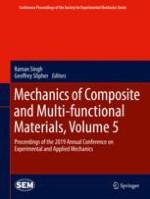2020 | Book
Mechanics of Composite and Multi-functional Materials, Volume 5
Proceedings of the 2019 Annual Conference on Experimental and Applied Mechanics
Editors: Prof. Raman Singh, Dr. Geoffrey Slipher
Publisher: Springer International Publishing
Book Series : Conference Proceedings of the Society for Experimental Mechanics Series
